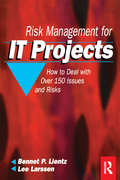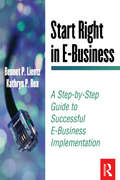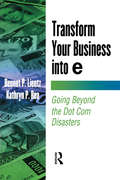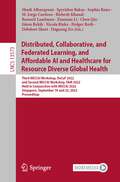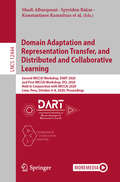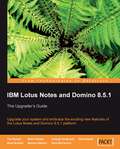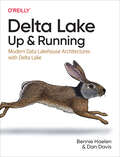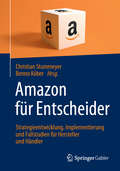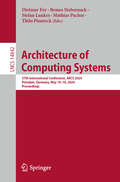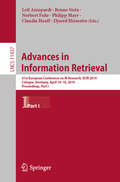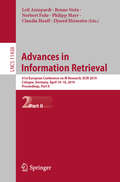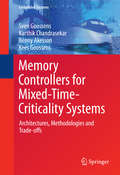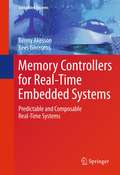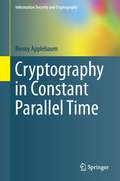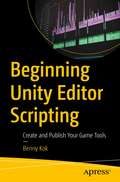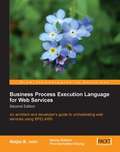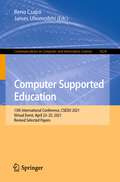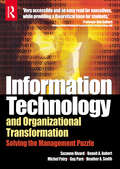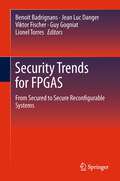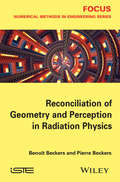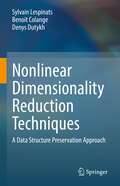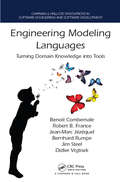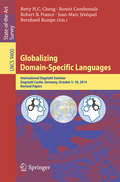- Table View
- List View
Risk Management for IT Projects
by Bennet Lientz Lee LarssenThe rate of failure of IT projects has remained little changed in survey after survey over the past 15-20 years—over 40-50%. This has happened in spite of new technology, innovative methods and tools, and different management methods. Why does this happen? Why can’t the situation be better? One reason is that many think of each IT effort as unique. In reality many IT projects are very similar at a high, strategic level. Where they differ is in the people and exact events—the detail. If you read the literature or have been in information systems or IT for some time, you have seen the same reasons for failure and the same problems and issues recur again and again. In this book IT Management experts Ben Lientz and Lee Larssen show you how to identify and track the recurring issues leading to failure in IT projects and provide a proven, modern method for addressing them. By following the recommendations in this books readers can significantly reduce the risk of IT failures and increase the rate of success. Benefits of using this approach:• Issues are identified earlier—giving more time for solution and action.• Issues are resolved more consistently since the approach tracks on their repetition.• You get an early warning of problems in IT work—before the budget or schedule fall apart.• Management tends to have more realistic expectations with an awareness of issues.• Users and managers have greater confidence in IT due to the improved handling of issues.• Since the number of issues tends to stabilize in an organization, the IT organization and management get better at detecting, preventing, and dealing with issues over time—cumulative improvement.• Giving attention to issues make users more realistic in their requests and acts to deter requirement changes and scope creep.
Start Right in E-Business
by Bennet Lientz Kathryn ReaE-business occurs when a company has established critical business procedures and activities to support e-commerce transactions. Using this definition, e-commerce is part of e-business--a company needs e-commerce to implement e-business. Utilizing e-commerce, however, does not mean that a company has transformed into an e-business. E-business is implemented only when a company changes its internal procedures to take advantage of the e-commerce technologies.Interest in the evolution ("e-volution") of e-commerce into e-business is a growth field. With the early November announcement that GM and Ford were forming online marketplaces for their suppliers, they placed themselves at the center of new e-business ecosystems that will transform their entire way of doing business. Many firms are increasingly discovering opportunities to move away from simply selling products on the Internet to being able to reinvent their conventional supply chains (as in the auto makers' case) and to being able to offer custom-built products (as Dell Computers does now).
Transform Your Business into E
by Bennet Lientz Kathryn ReaSurveys indicate that many E-Business efforts either fail or disrupt the basic business processes and transactions. E-Business is sometimes not aligned with the business or IT. Vague vision statements are not translated into specific actions related to E- Business. It is because of these factors that Transform Your Business into e was written. The book covers E-Business from the review of the business at the start to expanding E-Business after it is live.
Distributed, Collaborative, and Federated Learning, and Affordable AI and Healthcare for Resource Diverse Global Health: Third MICCAI Workshop, DeCaF 2022, and Second MICCAI Workshop, FAIR 2022, Held in Conjunction with MICCAI 2022, Singapore, September 18 and 22, 2022, Proceedings (Lecture Notes in Computer Science #13573)
by M. Jorge Cardoso Shadi Albarqouni Spyridon Bakas Islem Rekik Bennett Landman Nicola Rieke Holger Roth Daguang Xu Bishesh Khanal Debdoot Sheet Xiaoxiao Li Sophia Bano Chen QinThis book constitutes the refereed proceedings of the Third MICCAI Workshop on Distributed, Collaborative, and Federated Learning, DeCaF 2022, and the Second MICCAI Workshop on Affordable AI and Healthcare, FAIR 2022, held in conjunction with MICCAI 2022, in Singapore in September 2022. FAIR 2022 was held as a hybrid event.DeCaF 2022 accepted 14 papers from the 18 submissions received. The workshop aims at creating a scientific discussion focusing on the comparison, evaluation, and discussion of methodological advancement and practical ideas about machine learning applied to problems where data cannot be stored in centralized databases or where information privacy is a priority. For FAIR 2022, 4 papers from 9 submissions were accepted for publication. The topics of the accepted submissions focus on deep ultrasound segmentation, portable OCT image quality enhancement, self-attention deep networks and knowledge distillation in low-regime setting.
Domain Adaptation and Representation Transfer, and Distributed and Collaborative Learning: Second MICCAI Workshop, DART 2020, and First MICCAI Workshop, DCL 2020, Held in Conjunction with MICCAI 2020, Lima, Peru, October 4–8, 2020, Proceedings (Lecture Notes in Computer Science #12444)
by M. Jorge Cardoso Shadi Albarqouni Spyridon Bakas Bennett Landman Fausto Milletari Nicola Rieke Ziyue Xu Konstantinos Kamnitsas Wenqi Li Holger Roth Daguang XuThis book constitutes the refereed proceedings of the Second MICCAI Workshop on Domain Adaptation and Representation Transfer, DART 2020, and the First MICCAI Workshop on Distributed and Collaborative Learning, DCL 2020, held in conjunction with MICCAI 2020 in October 2020. The conference was planned to take place in Lima, Peru, but changed to an online format due to the Coronavirus pandemic. For DART 2020, 12 full papers were accepted from 18 submissions. They deal with methodological advancements and ideas that can improve the applicability of machine learning (ML)/deep learning (DL) approaches to clinical settings by making them robust and consistent across different domains.For DCL 2020, the 8 papers included in this book were accepted from a total of 12 submissions. They focus on the comparison, evaluation and discussion of methodological advancement and practical ideas about machine learning applied to problems where data cannot be stored in centralized databases; where information privacy is a priority; where it is necessary to deliver strong guarantees on the amount and nature of private information that may be revealed by the model as a result of training; and where it's necessary to orchestrate, manage and direct clusters of nodes participating in the same learning task.
IBM Lotus Notes and Domino 8.5.1
by Bennie GibsonThis book walks through the new features of the Lotus Notes/Domino 8.5.1 suite and documents technical features in a descriptive way, with examples and useful screenshots. The book also discusses likely problems you might face while upgrading, and shows how to get the most out of the exciting new features. This book is for Lotus Notes power users, administrators, and developers working with any version of Lotus Notes/Domino, who want to upgrade to Lotus Notes/Domino 8.5.1. Additionally, it can be leveraged by management to gain a high-level understanding of the new features and capabilities offered within the products.
Delta Lake: Modern Data Lakehouse Architectures with Delta Lake
by Bennie Haelen Dan DavisWith the surge in big data and AI, organizations can rapidly create data products. However, the effectiveness of their analytics and machine learning models depends on the data's quality. Delta Lake's open source format offers a robust lakehouse framework over platforms like Amazon S3, ADLS, and GCS.This practical book shows data engineers, data scientists, and data analysts how to get Delta Lake and its features up and running. The ultimate goal of building data pipelines and applications is to gain insights from data. You'll understand how your storage solution choice determines the robustness and performance of the data pipeline, from raw data to insights.You'll learn how to:Use modern data management and data engineering techniquesUnderstand how ACID transactions bring reliability to data lakes at scaleRun streaming and batch jobs against your data lake concurrentlyExecute update, delete, and merge commands against your data lakeUse time travel to roll back and examine previous data versionsBuild a streaming data quality pipeline following the medallion architecture
Amazon für Entscheider: Strategieentwicklung, Implementierung und Fallstudien für Hersteller und Händler
by Christian Stummeyer Benno KöberDieses Buch unterstützt Hersteller und Händler, die für sie richtige Amazon-Marktplatz-Strategie zu entwickeln. 14 ausgewiesene Experten erläutern im Detail, wie eine erfolgreiche Implementierung auf dem Amazon Marketplace funktionieren und wie das Amazon-Ecosystem effektiv genutzt werden kann. Fallstudien aus dem B2B- und B2C-Bereich zeigen, wie Amazon-Verkaufsstrategien erfolgreich umgesetzt werden können. Trotz des enormen Marktanteils des E-Commerce-Riesen schenken viele Unternehmen diesem Verkaufskanal immer noch nicht die nötige Aufmerksamkeit. Dies gilt nicht nur für den B2C-Markt, sondern auch im B2B-Umfeld, für das das Unternehmen aus Seattle unter Amazon Business die Möglichkeit bietet, schnell und unkompliziert zu verkaufen. In diesem Buch erhalten Sie Antworten auf Fragen wie „Amazon – ja oder nein?“ oder „Wie sieht eine erfolgversprechende Amazon-Vertriebsstrategie aus?“ sowie umfangreiches Entscheider-Wissen: von der Gestaltung einer verkaufsstarken Produktdetailseite über relevante Logistikanforderungen bis hin zu Markenschutz und rechtlichen Aspekten.Die ThemenAmazon verstehen und passgenaue Strategien entwickelnExemplarische Amazon-Strategien (Seller defensiv, Seller offensiv, Vendor B2C-B2B)Optimierung der ProduktdetailseitenEinsatz von Amazon Sponsored AdsProduktbewertungen auf AmazonGesetzliche Anforderungen und Amazon-RichtlinienLogistikkompetenz als wesentlicher TreiberProdukt- und Markenschutz auf AmazonAmazon Readiness: Prozesse, Systeme und Organisation für Profitabilität und SkalierbarkeitDas Ökosystem rund um AmazonB2B- und B2C-Fallstudien„Wie halte ich es mit Amazon? Das ist und bleibt eines der wichtigsten Strategiethemen für Handel und Industrie. Deshalb kommt „Amazon für Entscheider“ zur richtigen Zeit. Es beleuchtet die Amazon-Welt aus unterschiedlichsten Perspektiven und liefert so wertvolle Einsichten, indem es die Möglichkeiten gleichermaßen in Theorie und Praxis untersucht. Amazon-Insider und Branchenbeobachter mit langjähriger Erfahrung schärfen den Blick auf Amazon.“Jochen Krisch, excitingcommerce.deAus dem InhaltTEIL I. AMAZON VERSTEHEN UND PASSGENAUE STRATEGIEN ENTWICKELNAmazons Masterplan (Christian Stummeyer)Das Prinzip Amazon (Benno Köber)Der E-Commerce-Treiberbaum beim Vertrieb über den Amazon Marketplace (Christian Stummeyer)Entwicklung einer Amazon-Strategie (Ralph Ch. Hübner)Plattformzeitalter: Alternativen zu Amazon (Ralph Ch. Hübner)TEIL II. ENTSCHEIDENDE ERFOLGSBAUSTEINE KONZIPIEREN UND IMPLEMENTIERENOptimierung der Produktdetailseiten und deren Reichweite auf dem Amazon Marketplace (Adrian Jaroszyński)Strategische Grundlagen für den Einsatz von Amazon Sponsored Ads (Adrian Jaroszyński)Produktbewertungen auf Amazon: Relevanz und Handlungsfelder für Unternehmen (Christian Driehaus)Gesetzliche Anforderungen, Rahmenbedingungen und Amazon Richtlinien beim Verkauf über den Amazon Marketplace (Sabine Heukrodt-Bauer)Logistik als wesentlicher Treiber des Erfolgs für und mit Amazon (Oliver Lucas)Amazon Readiness: Prozesse, Systeme und Organisation um den Amazon Marketplace profitabel und skalierbar zu bespielen (Martin Himmel)Fulfillment by Amazon (Benno Köber)Amazon Business für den B2B-Markt (Lennart Paul)Produkt und Markenschutz auf Amazon (Jochen Schäfer)Das Ökosystem rund um Amazon (Benno Köber)TEIL III. FALLSTUDIENVom Amazon Pure Player zum Multi-Channel: Fahrradzubehör von AARON (Hans Mina) Selle
Architecture of Computing Systems: 37th International Conference, ARCS 2024, Potsdam, Germany, May 14–16, 2024, Proceedings (Lecture Notes in Computer Science #14842)
by Thilo Pionteck Dietmar Fey Stefan Lankes Benno Stabernack Mathias PacherThis book constitutes the proceedings of the 37th International Conference on Architecture of Computing Systems, ARCS 2024, held in Potsdam, Germany, in May 2024. The 23 papers presented in this volume were carefully reviewed and selected from 33 submissions. These papers have been categorized in the following sections: Progress in Neural Networks; Organic Computing; Computer Architecture Co-Design; Progress in HPC; Computer Architectures; and Dependability and Fault Tolerance.
Advances in Information Retrieval: 41st European Conference on IR Research, ECIR 2019, Cologne, Germany, April 14–18, 2019, Proceedings, Part I (Lecture Notes in Computer Science #11437)
by Norbert Fuhr Claudia Hauff Leif Azzopardi Benno Stein Philipp Mayr Djoerd HiemstraThis two-volume set LNCS 11437 and 11438 constitutes the refereed proceedings of the 41st European Conference on IR Research, ECIR 2019, held in Cologne, Germany, in April 2019. The 48 full papers presented together with 2 keynote papers, 44 short papers, 8 demonstration papers, 8 invited CLEF papers, 11 doctoral consortium papers, 4 workshop papers, and 4 tutorials were carefully reviewed and selected from 365 submissions. They were organized in topical sections named: Modeling Relations; Classification and Search; Recommender Systems; Graphs; Query Analytics; Representation; Reproducibility (Systems); Reproducibility (Application); Neural IR; Cross Lingual IR; QA and Conversational Search; Topic Modeling; Metrics; Image IR; Short Papers; Demonstration Papers; CLEF Organizers Lab Track; Doctoral Consortium Papers; Workshops; and Tutorials.
Advances in Information Retrieval: 41st European Conference on IR Research, ECIR 2019, Cologne, Germany, April 14–18, 2019, Proceedings, Part II (Lecture Notes in Computer Science #11438)
by Norbert Fuhr Claudia Hauff Leif Azzopardi Benno Stein Philipp Mayr Djoerd HiemstraThis two-volume set LNCS 11437 and 11438 constitutes the refereed proceedings of the 41st European Conference on IR Research, ECIR 2019, held in Cologne, Germany, in April 2019. The 48 full papers presented together with 2 keynote papers, 44 short papers, 8 demonstration papers, 8 invited CLEF papers, 11 doctoral consortium papers, 4 workshop papers, and 4 tutorials were carefully reviewed and selected from 365 submissions. They were organized in topical sections named: Modeling Relations; Classification and Search; Recommender Systems; Graphs; Query Analytics; Representation; Reproducibility (Systems); Reproducibility (Application); Neural IR; Cross Lingual IR; QA and Conversational Search; Topic Modeling; Metrics; Image IR; Short Papers; Demonstration Papers; CLEF Organizers Lab Track; Doctoral Consortium Papers; Workshops; and Tutorials.
Memory Controllers for Mixed-Time-Criticality Systems
by Kees Goossens Benny Akesson Sven Goossens Karthik ChandrasekarThis book discusses the design and performance analysis of SDRAM controllers that cater to both real-time and best-effort applications, i. e. mixed-time-criticality memory controllers. The authors describe the state of the art, and then focus on an architecture template for reconfigurable memory controllers that addresses effectively the quickly evolving set of SDRAM standards, in terms of worst-case timing and power analysis, as well as implementation. A prototype implementation of the controller in SystemC and synthesizable VHDL for an FPGA development board are used as a proof of concept of the architecture template.
Memory Controllers for Real-Time Embedded Systems
by Kees Goossens Benny AkessonVerification of real-time requirements in systems-on-chip becomes more complex as more applications are integrated. Predictable and composable systems can manage the increasing complexity using formal verification and simulation. This book explains the concepts of predictability and composability and shows how to apply them to the design and analysis of a memory controller, which is a key component in any real-time system.
Cryptography in Constant Parallel Time (Information Security and Cryptography)
by Benny ApplebaumLocally computable (NC0) functions are "simple" functions for which every bit of the output can be computed by reading a small number of bits of their input. The study of locally computable cryptography attempts to construct cryptographic functions that achieve this strong notion of simplicity and simultaneously provide a high level of security. Such constructions are highly parallelizable and they can be realized by Boolean circuits of constant depth. This book establishes, for the first time, the possibility of local implementations for many basic cryptographic primitives such as one-way functions, pseudorandom generators, encryption schemes and digital signatures. It also extends these results to other stronger notions of locality, and addresses a wide variety of fundamental questions about local cryptography. The author's related thesis was honorably mentioned (runner-up) for the ACM Dissertation Award in 2007, and this book includes some expanded sections and proofs, and notes on recent developments. The book assumes only a minimal background in computational complexity and cryptography and is therefore suitable for graduate students or researchers in related areas who are interested in parallel cryptography. It also introduces general techniques and tools which are likely to interest experts in the area.
Maschinelles Lernen - Grundlagen und Anwendungen: Mit Beispielen in Python
by Benny BotschIn diesem Fachbuch werden vorwiegend die Grundlagen des Maschinellen Lernens erläutert. Die Hauptthemen sind die mathematischen Grundlagen, Optimierungsmethoden und die ML-Algorithmen. Es wird zu jedem Kapitel mindestens eine Beispiel-Übung durchgeführt. Die Übungen könnten durch Python-Code ergänzt werden. Zusätzlich werden Aufgabenstellungen definiert, dies dient der Festigung des in dem jeweiligen Kapitel gelernten. Spezielle Anwendungen sollen ebenfalls dargestellt werden. Die Zielgruppe sind hauptsächlich Studierende, welche sich in dieses Themengebiet einarbeiten möchten. Ingenieure können allerdings ebenfalls von diesem Fachbuch profitieren, da ein großer Schwerpunkt bei der Anwendung von ML liegt. Besonders die Verwendung in interdisziplinären Fachrichtungen wie der Regelungstechnik, Bildverarbeitung und der Chemie werden aufgezeigt.
Beginning Unity Editor Scripting: Create and Publish Your Game Tools
by Benny KokLearn about editor scripting in Unity, including different possible methods of editor customization to fit your custom game workflow or even to create assets that could be published on the Asset Store to earn a passive income. The knowledge of editor scripting, although rarely covered in books, gives a game developer insight into how things work in Unity under the hood, which you can leverage to create custom tools that empower your unique game idea. This book starts with the very basics of editor scripting in Unity, such as using built-in attributes to customize your component’s editor and creating custom editors and windows with IMGUI and UI Toolkit. Next, we move to a general use case example by creating an object spawner EditorTool for the scene view. Later, we dive straight to in-depth stats and detailed case studies of two Unity assets: ProArray and Rhythm Game Starter. Here you’ll get more context on how editor scripting is used in published assets. You will also learn how to set up a better workflow for editor scripting, asset publishing, maintenance, and iterative updates. You will leverage the power of modern web technology to build a documentation site with GitBook and DocFX. Finally, you will see some tips and tricks for automating asset versioning and changelogs. What You Will Learn Get started with Editor scripting in Unity Work with advanced editor topics such as custom EditorWindows and EditorTool Structure your C# code with namespaces and asmdef Use IMGUI and UI Toolkit for creating editor GUIs Master packaging and selling your own editor tools Set up a better workflow for asset publishing, maintenance, and iterative updates Who This Book Is For Readers who want to learn about editor scripting to improve their game-development process and create tools for themselves. Moderate experience with C# and a fundamental knowledge of Unity is expected.
Business Process Execution Language for Web Services Second Edition
by Benny MathewThis book is aimed at architects and developers in the design, implementation, and integration phases of advanced information systems and e-business solutions, developing business processes and dealing with the issues of composition, orchestration, transactions, coordination, and security. The book presumes knowledge of XML and web services, web services development (either on J2EE or .NET), and multi-tier architecture
Alternative Portraiture
by Benny MigsIn this book, Benny Migliorino teaches readers how to work with speedlights-lightweight, relatively inexpensive, and powerful palm-sized flash units-to create dramatic, dimensional, flattering lighting. 'Migs' presents 60 portraits shot in a wide range of environments-from cramped quarters and fluorescent light, to dimly lit rooms, to makeshift "studio" spaces in a client's home or office. Readers will learn critical lighting skills from reducing the contrast range and creating softer, more flattering light; to re-creating traditional studio lighting patterns in varied existing-light scenarios; to adding fill for a rounder, more dimensional view of the subject; to overpowering the existing light; and working in mixed-light scenarios. Whether you're working solo or with an assistant, with one speedlight or multiple units, using "bare" (unmodified) small flash or harnessing its power via flash-mounted or freestanding light modification devices, you will learn how to make quick work of creating professional, evocative portraits that bring out the best version of your subject and highlight the personal connection he or she has to their personal environment.
Computer Supported Education: 13th International Conference, CSEDU 2021, Virtual Event, April 23–25, 2021, Revised Selected Papers (Communications in Computer and Information Science #1624)
by James Uhomoibhi Beno CsapóThis book constitutes selected, revised and extended papers from the 13th International Conference on Computer Supported Education, CSEDU 2021, held as a virtual event in April 2021.The 27 revised full papers were carefully reviewed and selected from 143 submissions. They were organized in topical sections as follows: artificial intelligence in education; information technologies supporting learning; learning/teaching methodologies and assessment; social context and learning environments; ubiquitous learning; current topics.
Information Technology and Organizational Transformation: Solving The Management Puzzle
by Heather Smith Suzanne Rivard Benoit Aubert Michel Patry Guy PareThis text is designed to help managers who have to deal with a complex environment, and who are often presented with "ready-made" solutions as to how to best organize their firm, to best use information technology. The book presents a simple and attractive framework within which managers can analyze their firm's environment and characteristics, and reflect on the most appropriate way - for them - to "put the puzzle together." It provides the manager and student with an integrated conceptual but pragmatic framework to analyze their situation. Courses examining the role of Information Technology in emerging organizational forms will find a well-grounded conceptual framework, illustrated with in-depth case studies. The book draws from the latest research in industrial organization, strategy, information technology, organizational theory, and leadership. It examines the individual puzzle pieces that have to be put together - strategy, structure, information technology, and leadership, and present the cases of three firms that were equally successful in putting these pieces together, while choosing pieces with dramatically different forms and adjusting them in radically different ways.The three in-depth cases included in the book are international:Oticon is a Danish firm with close to 1500 employees and is a world leader in the manufacture of hearing aids. Li & Fung is another, fist established in Canton and is an international trading company.Progressive Insurance which is the third largest insurance company in the US.
Security Trends for FPGAS
by Jean Luc Danger Benoit Badrignans Guy Gogniat Viktor Fischer Lionel TorresIn Security Trends for FPGA's the authors present an analysis of current threats against embedded systems and especially FPGAs. They discuss about requirements according to the FIPS standard in order to build a secure system. This point is of paramount importance as it guarantees the level of security of a system. Also highlighted are current vulnerabilities of FPGAs at all the levels of the security pyramid. It is essential from a design point of view to be aware of all the levels in order to provide a comprehensive solution. The strength of a system is defined by its weakest point; there is no reason to enhance other protection means, if the weakest point remains untreated. Many severe attacks have considered this weakness in order not to face brute force attack complexity. Several solutions are proposed in Security Trends for FPGA's especially at the logical, architecture and system levels in order to provide a global solution.
Reconciliation of Geometry and Perception in Radiation Physics
by Benoit Beckers Pierre BeckersReconciliation of Geometry and Perception in Radiation Physics approaches the topic of projective geometry as it applies to radiation physics and attempts to negate its negative reputation. With an original outlook and transversal approach, the book emphasizes common geometric properties and their potential transposition between domains. After defining both radiation and geometric properties, authors Benoit and Pierre Beckers explain the necessity of reconciling geometry and perception in fields like architectural and urban physics, which are notable for the regularity of their forms and the complexity of their interactions.
Nonlinear Dimensionality Reduction Techniques: A Data Structure Preservation Approach
by Denys Dutykh Sylvain Lespinats Benoit ColangeThis book proposes tools for analysis of multidimensional and metric data, by establishing a state-of-the-art of the existing solutions and developing new ones. It mainly focuses on visual exploration of these data by a human analyst, relying on a 2D or 3D scatter plot display obtained through Dimensionality Reduction. Performing diagnosis of an energy system requires identifying relations between observed monitoring variables and the associated internal state of the system. Dimensionality reduction, which allows to represent visually a multidimensional dataset, constitutes a promising tool to help domain experts to analyse these relations. This book reviews existing techniques for visual data exploration and dimensionality reduction such as tSNE and Isomap, and proposes new solutions to challenges in that field. In particular, it presents the new unsupervised technique ASKI and the supervised methods ClassNeRV and ClassJSE. Moreover, MING, a new approach for local map quality evaluation is also introduced. These methods are then applied to the representation of expert-designed fault indicators for smart-buildings, I-V curves for photovoltaic systems and acoustic signals for Li-ion batteries.
Engineering Modeling Languages: Turning Domain Knowledge into Tools (Chapman & Hall/CRC Innovations in Software Engineering and Software Development Series #7590)
by Benoit Combemale Jean-Marc Jézéquel Bernhard Rumpe James Steel Robert France Didier VojtisekWritten by foremost experts in the field, Engineering Modeling Languages provides end-to-end coverage of the engineering of modeling languages to turn domain knowledge into tools. The book provides a definition of different kinds of modeling languages, their instrumentation with tools such as editors, interpreters and generators, the integration of multiple modeling languages to achieve a system view, and the validation of both models and tools. Industrial case studies, across a range of application domains, are included to attest to the benefits offered by the different techniques. The book also includes a variety of simple worked examples that introduce the techniques to the novice user. The book is structured in two main parts. The first part is organized around a flow that introduces readers to Model Driven Engineering (MDE) concepts and technologies in a pragmatic manner. It starts with definitions of modeling and MDE, and then moves into a deeper discussion of how to express the knowledge of particular domains using modeling languages to ease the development of systems in the domains. The second part of the book presents examples of applications of the model-driven approach to different types of software systems. In addition to illustrating the unification power of models in different software domains, this part demonstrates applicability from different starting points (language, business knowledge, standard, etc.) and focuses on different software engineering activities such as Requirement Engineering, Analysis, Design, Implementation, and V&V. Each chapter concludes with a small set of exercises to help the reader reflect on what was learned or to dig further into the examples. Many examples of models and code snippets are presented throughout the book, and a supplemental website features all of the models and programs (and their associated tooling) discussed in the book.
Globalizing Domain-Specific Languages
by Betty H. C. Cheng Benoit Combemale Robert B. France Jean-Marc Jézéquel Bernhard RumpeThe development of modern complex software-intensive systems often involves the use of multiple DSMLs that capture different system aspects. Supporting coordinated use of DSMLs leads to what we call the globalization of modeling languages, that is, the use of multiple modeling languages to support coordinated development of diverse aspects of a system. In this book, a number of articles describe the vision and the way globalized DSMLs currently assist integrated DSML support teams working on systems that span many domains and concerns to determine how their work on a particular aspect influences work on other aspects. Globalized DSMLs offer support for communicating relevant information, and for coordinating development activities and associated technologies within and across teams, in addition to providing support for imposing control over development artifacts produced by multiple teams. DSMLs can be used to support socio-technical coordination by providing the means for stakeholders to bridge the gap between how they perceive a problem and its solution, and the programming technologies used to implement a solution. They also support coordination of work across multiple teams. DSMLs developed in an independent manner to meet the specific needs of domain experts have an associated framework that regulates interactions needed to support collaboration and work coordination across different system domains. The articles in the book describe how multiple heterogeneous modeling languages (or DSMLs) can be related to determine how different aspects of a system influence each other. The book includes a research roadmap that broadens the current DSML research focus beyond the development of independent DSMLs to one that provides support for globalized DSMLs.
